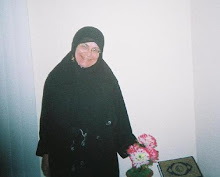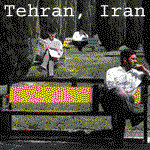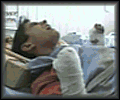Desert of trapped corpses testifies to Israel's failure
08/15/06 "The Independent" -- -- They made a desert and called it peace. Srifa - or what was once the village of Srifa - is a place of pancaked homes, blasted walls, rubble, starving cats and trapped corpses. But it is also a place of victory for the Hizbollah, whose fighters walked amid the destruction yesterday with the air of conquering heroes. So who is to blame for this desert? The Shia militia which provoked this war - or the Israeli air force and army which has laid waste to southern Lebanon and killed so many of its people?
There was no doubt what the village mukhtar thought. As three Hizbollah men - one wounded in the arm, the other carrying two ammunition clips and a two-way radio - passed us amid the piles of broken concrete, Hussein Kamel el-Din yelled to them: "Hallo, heroes!" Then he turned to me. "You know why they are angry? Because God didn't give them the opportunity of dying."
You have to be down here with the Hizbollah amid this terrifying destruction - way south of the Litani river, in the territory from which Israel once vowed to expel them - to realise the nature of the past month of war and of its enormous political significance to the Middle East. Israel's mighty army has already retreated from the neighbouring village of Ghandoutiya after losing 40 men in just over 36 hours of fighting. It has not even managed to penetrate the smashed town of Khiam where the Hizbollah were celebrating yesterday afternoon. In Srifa, I stood with Hizbollah men looking at the empty roads to the south and could see all the way to Israel and the settlement of Mizgav Am on the other side of the frontier. This is not the way the war was supposed to have ended for Israel.
Far from humiliating Iran and Syria - which was the Israeli-American plan - these two supposedly pariah states have been left untouched and the Hizbollah's reputation lionised across the Arab world. The "opportunity" which President George Bush and his Secretary of State, Condoleezza Rice, apparently saw in the Lebanon war has turned out to be an opportunity for America's enemies to show the weakness of Israel's army. Indeed, last night, scarcely any Israeli armour was to be seen inside Lebanon - just one solitary tank could be glimpsed outside Bint Jbeil and the Israelis had retreated even from the "safe" Christian town of Marjayoun. It is now clear that the 30,000-strong Israeli army reported to be racing north to the Litani river never existed. In fact, it is unlikely that there were yesterday more than 1,000 Israeli soldiers left in all of southern Lebanon, although they did become involved in two fire-fights during the morning, hours after the UN-ceasefire went into effect.
Down the coast road from Beirut, meanwhile, came a massive exodus of tens of thousands of Shia families, bedding piled on the roofs of their cars , many of them sporting Hizbollah flags and pictures of Sayed Hassan Nasrallah, Hizbollah's chairman, on their windscreens. At the massive traffic jams around the broken motorway bridges and craters which litter the landscape, the Hizbollah was even handing out yellow and green "victory" flags, along with official notices urging parents not to allow children to play with the thousands of unexploded bombs that now lie across the landscape. At least one Lebanese child was killed by unexploded ordnance and another 15 were wounded yesterday.
But to what are these people returning? Haj Ali Dakroub, a 42-year old construction manager, lost part of his home in Israel's 1996 bombardment of Srifa. Now his entire house has been flattened. "What is here that Israel should destroy all this?" he asked. "We don't deny that the resistance was in Srifa. It was here before and it will be here in the future. But in this house lived only my family. So why would Israel bomb it?"
Well, I did happen to notice what appeared to be the casing of a missile hanging from the balcony of a much-damaged house facing the rubble of Ali Dakroub's home. And a group of Hizbollah militiamen, one of them with a pistol tucked into his trousers, walked past us nonchalantly and disappeared into an orchard. Was this, perhaps, where they kept some of their rockets?
Mr Dakroub wasn't saying. "I am going to rebuild my home with my two sons," he insisted. "Israel may come back in 10 years and destroy it all over again and then I'll just rebuild it all over again. This was a Hizbollah victory. The Israelis were able to defeat all the Arab countries in six days in 1967 but here they could not defeat the resistance in a month. These resistance men would come out of the ground and shoot back. They are still here."
"Come out of the ground" is an expression I have heard several times these past four weeks and I am beginning to suspect that many of the thousands of guerrillas did indeed shelter in caves and basements and tunnels, only to emerge to fire their missiles or to use their infra-red rockets on the Israeli army once it made the mistake of sending troops into Lebanon on the ground. And does anyone believe that the Hizbollah will submit to their own disarmament by a new international force of UN and Lebanese troops once - if - it arrives? There was a symbolic moment yesterday when Lebanese soldiers already based in southern Lebanon joined Hizbollah men in Srifa to clear the rubble of a house in which the bodies of an entire family were believed buried. Lebanese Red Cross and civil defence personnel - representatives of the civil power which is supposed to claw back its sovereignty from the Hizbollah - joined in the search. The mukhtar, who so blatantly regarded the Hizbollah as heroes, is also a government representative. And at the entrance to this shattered village still stands a poster of Nasrallah and the Iranian President Ali Khamenei.
Far from driving the Hizbollah north across the Litani river, Israel has entrenched them in their Lebanese villages as never before.














0 Comments:
Post a Comment
<< Home